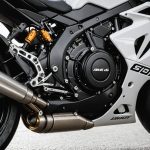Ultimate Guide to Navigating UK Emissions Regulations: Sport Bike Compliance Made Easy
As the UK continues to tighten its grip on emissions to achieve net zero goals, navigating the complex web of regulations can be daunting, especially for sport bike enthusiasts. This guide is designed to break down the key aspects of UK emissions regulations, ensuring your sport bike remains road legal and compliant with the latest standards.
Understanding the UK Emissions Landscape
The UK’s commitment to improving air quality and reducing emissions is evident in the various initiatives and regulations being implemented. One of the most significant changes is the expansion of the Ultra Low Emission Zone (ULEZ) in London.
In parallel : Essential strategies to maximize sport bike tire lifespan in the uk
London ULEZ and Its Implications
As of 2025, the London ULEZ will be expanded, and even zero-emission cars, vans, and bikes will be subject to the congestion charge from December 25, 2025. This move is part of a broader strategy to reduce emissions and improve air quality in the capital.
“`quote
“The London congestion charge will be payable for zero emission cars, vans and bikes from 25th December 2025,” – Source: [5].
In the same genre : Expert Tips for Perfect Sport Bike Tire Inflation in the UK’s Shifting Weather
This change highlights the need for all road users, including motorcyclists, to be aware of the evolving emissions standards and how they impact their daily commute.
Emissions Standards for Sport Bikes
Sport bikes, while exhilarating to ride, must comply with stringent emissions standards to be road legal. Here are some key points to consider:
Euro Emissions Standards
Sport bikes sold in the UK must adhere to the Euro emissions standards, which are periodically updated to reflect stricter emission controls. For instance, the current Euro 5 standards require significant reductions in emissions compared to previous norms.
Modifications and Compliance
When modifying your sport bike, it is crucial to ensure that any changes do not violate emissions regulations. Here are some guidelines from the SACU (Scottish Auto Cycle Union) regulations for Formula Supersport bikes, which can serve as a general guide:
- Fuel System: The original closed system must be retained; no direct atmospheric emission is permitted. Fuel pumps and fuel pressure regulators must remain as originally specified[1].
- Exhaust System: Exhaust pipes and silencers can be modified, but catalytic converters must be removed. The noise limit for 600cc machines is 105 dB/A with a 3 dB/A tolerance after the race[1].
Navigating Local Emission Zones
Local authorities across the UK are implementing their own emission zones, each with its own set of rules and charges.
ULEZ Charge and Exemptions
The ULEZ charge in London is a prime example. Here’s a detailed look at what you need to know:
| Vehicle Type | ULEZ Charge Applicable | Exemptions |
|---|---|---|
| Petrol Cars | Yes, if not Euro 4+ | Cars meeting Euro 4 or later standards |
| Diesel Cars | Yes, if not Euro 6+ | Cars meeting Euro 6 or later standards |
| Motorcycles | Yes, if not Euro 3+ | Motorcycles meeting Euro 3 or later standards |
| Electric Vehicles | No | All electric vehicles are exempt from the ULEZ charge |
Other Local Emission Zones
Other cities in the UK are also introducing their own emission zones. For example, Birmingham and Manchester have their own Clean Air Zones, which may have different criteria and charges.
Practical Tips for Compliance
To ensure your sport bike remains compliant, here are some practical tips:
Regular Maintenance
Regular maintenance is key to ensuring your bike meets emissions standards. Here are some steps you can take:
- Tune Your Engine: Regular tuning can help maintain optimal engine performance and reduce emissions.
- Check Your Exhaust: Ensure your exhaust system is in good condition and meets the noise and emissions standards.
- Use Approved Parts: When modifying your bike, use parts that are approved and compliant with emissions regulations.
Stay Informed
Keeping up with the latest regulations and changes is crucial. Here are some resources to help you stay informed:
- Government Websites: Regularly check government websites such as the DVSA (Driver and Vehicle Standards Agency) for updates on emissions regulations and changes to testing requirements[2].
- Motorcycle Associations: Joining motorcycle associations or clubs can provide you with timely updates and advice on compliance.
The Future of Motorcycling and Emissions
As the UK moves towards a greener future, the landscape for motorcycling is set to change significantly.
Electric Bikes and the Future
Electric bikes are becoming increasingly popular, and they offer a compelling alternative to traditional petrol-powered bikes. Here’s what you need to know:
- Zero Emissions: Electric bikes produce zero tailpipe emissions, making them an attractive option for those looking to reduce their environmental impact.
- ULEZ Exemptions: Electric bikes are exempt from the ULEZ charge, making them a cost-effective option for commuting in emission-controlled zones.
“`quote
“Electric bikes are an exciting development in the motorcycling world, offering a sustainable and cost-effective alternative to traditional bikes,” – Source: [4].
Active Travel and Public Transport Integration
The UK is also focusing on integrating active travel and public transport to reduce reliance on personal vehicles. Here are some initiatives to watch:
- Cycling Infrastructure: Improvements in cycling infrastructure are aimed at encouraging more people to use bikes as a mode of transport.
- Public Transport Enhancements: Enhancements to public transport systems, including buses and trains, are designed to make them more efficient and appealing.
Navigating the UK’s emissions regulations for sport bikes requires a thorough understanding of the current standards and upcoming changes. By staying informed, maintaining your bike regularly, and considering sustainable alternatives, you can ensure your sport bike remains road legal and compliant.
Key Takeaways
- Stay Updated: Regularly check for updates on emissions regulations and testing requirements.
- Maintain Your Bike: Regular maintenance is crucial for ensuring your bike meets emissions standards.
- Consider Electric Options: Electric bikes offer a sustainable and cost-effective alternative to traditional petrol-powered bikes.
- Support Active Travel: Encourage and support initiatives that promote active travel and public transport.
By following these guidelines and staying ahead of the curve, you can enjoy your sport bike while contributing to a cleaner, healthier environment for all road users.





